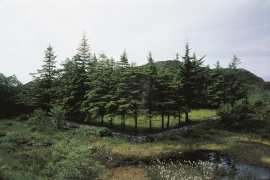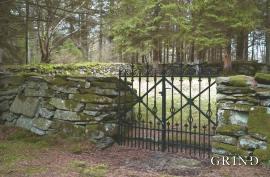- Remove Culture filter Culture
- Remove Cemeteries filter Cemeteries
- Remove Hydro power filter Hydro power

Møvik
In the winter of 1849 the impoverished Fjell municipality was forced to put money into new burial places at Møvik and Bildøydalen, because of the raging cholera epidemic. On 28 March the municipal council decided on a resolution “to apply to His Majesty the King most subserviently to be granted a loan of 500 Speciedaler …”

Hummelfossen
As early as 1906 the Matre and Haugsdal waterway was bought up by the businessman Blauuw from Bergen; the first “waterfall speculator” in the Matre area. He immediately resold it to Fr. Hiorth, who transferred all the rights to the company Matrefaldene in 1908. Behind A/S Matrefaldene were German interests, Badische Anilin und Sodafabrik, which wanted to start production of saltpetre fertilizer with nitrogen and electricity.

Stølsheimen
The large mountain area between Modalen, the Voss communities and Sogn is one of the finest mountain pasture areas in West Norway. In older times this area was called Steinslandsheimen, in our times it has acquired the name Stølsheimen. Power development and protection interests have been opposed here. The core area of Stølsheimen has now been protected as a landscape protection area, while some of the oldest mountain farms have been flooded. A register in the 1970s comprised almost 40 mountain farm settlements in the central area of Stølsheimen, belonging to Modalen, Høyanger and Vik municipalities.

Hystad- burial mounds
The biggest collection of prehistoric burial relics in Stord is to be found in Hystadmarka. There are still 16 burial mounds and two stone rings visible here; finds that span from the Bronze Age to the Viking Age in time.

Tyssedal
Today Tyssedal appears like a classical industrial community, a picture of modern Norway from the turn of the former century until today. A/S Tyssefaldene was established in 1906, and on 1 May 1908 Tyssedal power station was put into operation. The work on the first stage of the facility was completed in a short time, with a work force of 500 men. They built water tunnels, regulation reservoirs, power station, penstocks, harbour, cableways, office buildings, houses and 6 km of power lines in the wild mountains above Odda to provide the new melting plant with power.

Gåssand
The 28th November 1914 was a day to remember for the Os inhabitants. This was the day they could turn the switch on the wall and have electric light in their houses. It was like opening the door on the future when the power station at Gåssand was put into operation.


Dale power station
In 1923 Bergenshalvøens Kommunale Kraftselskap (BKK) expropriated large areas for power plants and development of hydropower started soon afterwards. Dale power station with the two first aggregates, each of 14 MW was put into operation on 17 November 1927. In the supply reservoir in Storefossen 5152 cubic metres of concrete were cast, and a modern and well-equipped power station was built.




